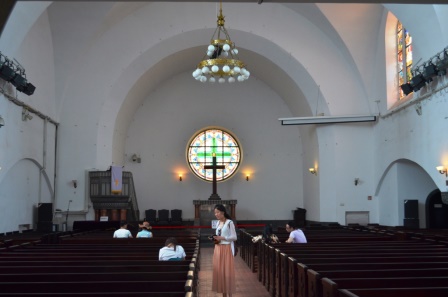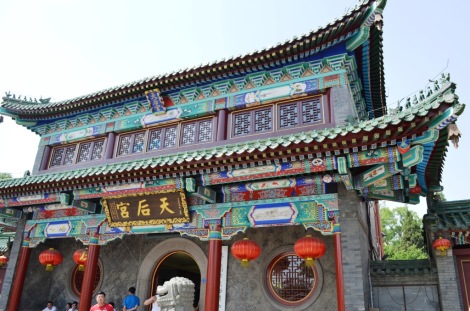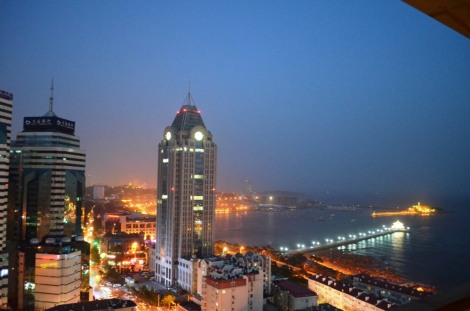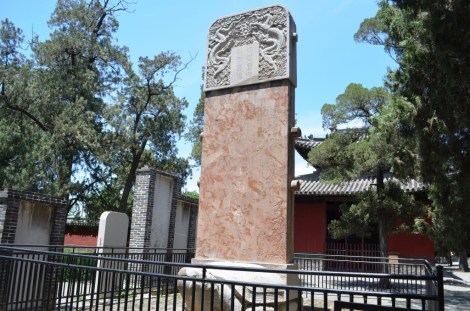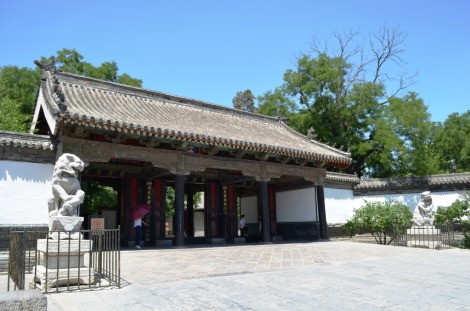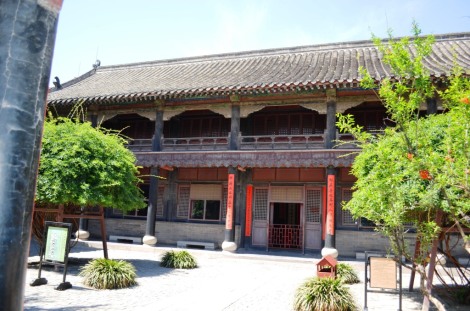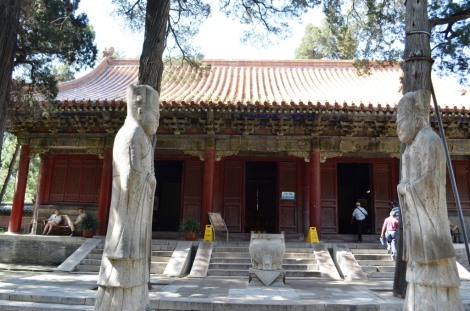From R:
27 May: Going a little stir-crazy and with all of my preparations for my thesis defense completed, I decided to escape the city for a short two day break. So, I woke up early and took the 5 hour train to Qingdao, which is a coastal town which had once contained a large German concession and, as a result, is most famous today (at least overseas) for its signature pilsner, Tsingtao, choice of most Chinese restaurants outside China.
Domestically, Qingdao is known as one to the nicest and most livable cities. Upon disembarking around noon, I could immediately see why. The streets were wide and clean, the buildings were all nice, the sky was blue, and there was a steady gentle sea breeze. And if seafood is your thing (which, for me, it’s not), then all the better. I checked in at a hotel right across from the train station and then set out to go see the sights. The train station is on one edge of what was once the concession area, and most of the sightseeing-worthy sites were in this district. Walking to the first destination, the old German governor’s mansion, I could definitely see the heavy German influence. The walk was nice and mostly along tree-lined streets.

The Qingdao Protestant Church was built by the Germans in 1910. It is still in use. Visitors can climb the bell tower and get a good view towards the harbor.
Unfortunately, when I got to the Governor’s mansion, I discovered a small flimsy sign that informed visitors that the site was temporarily closed for repairs. Eh, such is tourism in China. Anyways, that gave me an extra hour, so I decided to climb nearby Signal Hill, which was used by the Germans and had a signal station built on the top. Unfortunately, because it was rated a AAA tourist site, there was a ticket counter and a fee. I asked the ticket-seller if there was anything in the park like a museum or signs which explained the history of the hill. The answer to all was no, and so I decided to vote with my wallet by not paying.

The view from the Governor’s Mansion of the Church Steeple, with more modern high-rises in the background.
Next, I walked down to Tianhou temple. This was built during the Ming Dynasty, in the 15th century. Several deities were venerated here, and this was once a favorite temple of fisherman (it was practically on the beach), but while I was there I only saw one person actually there to pray, a woman who had apparently just returned by ferry from South Korea or Japan (based on the fact that she was carrying two large bags of duty-free items).
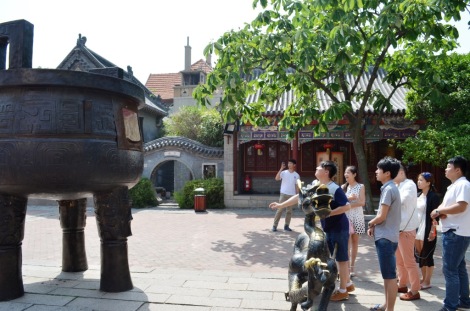
If you can throw a coin into the opening in the large Gui and get it to land on the small platform inside, then you will become rich.
It was much like any of the many temples we have visited, except I would say the signs were far more informative. There also appeared to be free(?) tour guides (people, not audio guides) for those with a large enough group. Anyways, what was also striking about this temple was that there must have been 60 people, other than the guides, employed here (most of them playing on their phones because only 10 were necessary, at most). Most of them were there to sell you things that supposedly increased your luck. So, aside from the usual merit boxes and such, the guides also brought people to the various side halls in which you could buy these little trinkets. I went into one such hall, and the very pushy sales lady kept trying to get me to buy a 20 CNY (3 US dollars) little medallion, telling me it would bring me luck. I don’t particularly get the appeal, but I did see group after group of young and old alike open up their pocketbooks as they funneled through the various halls. Maybe the money goes not just to salary for the 60 employees, but also some good use: in one of the halls, next to a merit box (for donations), I saw a plaque given by a local charity that helps children, thanking the temple for its financial support. Of course, how much of the donations get given to the charity, who knows. Also, I don’t have a completely positive view of charity in China, although I don’t want to deny that there are good people out there who mean well. Anyways, I digress…
From there, I walked over to the Naval History Museum. This was OK. It was listed as one of the 100 most important tourist sites for Red (ie. Communist) Tourism, so I can check that off my list. The museum section had some very basic displays, mostly large posters with lots of pictures, especially of the early days in the 1950’s. I was surprised that there was not more of a to-do about the Liaoning, China’s aircraft carrier, but maybe I just missed that section. About a third of the museum was dedicated to the various gifts given to high ranking admirals when they conducted overseas visits, so I skipped right through these. In all, I spent about 40 minutes in the museum itself (sorry, no photos were allowed)
Behind the museum is a football field sized lot of old airplanes, anti-aircraft guns, underwater mines, torpedoes, landing craft, and even a pair of tanks. It was alright, but the real draw is the fact that there are three retired navy ships that visitors can actually board. Only one of the three was open at the time I visited, however, due to ongoing maintenance. This ship was a carrier for helicopters. It was pretty cool. Visitors cannot enter the inside, but we were free to crawl around the deck and even up into the bridge. I will say I was definitely impressed with the size of the weapons. These were no joke. (Interestingly, I think this may have been the first time I have ever been aboard a naval vessel…except maybe the USS Constitution – which is technically still an active vessel. So, first time I have been aboard a naval vessel built post-18th century, and its a Chinese one!)

At one of gunner stations on this helicopter landing ship. The seats were so small I literally could not fit in them. (They were also filled with trash).
It seems to me that the PLA Navy was missing a great recruiting opportunity – the museum didn’t really try to inspire or capture the imagination of young men and women. However, next to the existing Naval Museum, a new museum building is being built and maybe that will be a bit more inspiring, interactive, etc. I wouldn’t not recommend the naval museum in its current form for anyone visiting Qingdao now, but if you had the choice you might want to wait until the new museum is completed.

A view back at Signal Hill with the observatories on top; the Protestant Church Steeple is on the left.
After the naval museum, I walked over to one of the municipal beaches, just to see if there was anything cool there. Not particularly, and so I caught a bus over to the other side of town, just on the edge of the business district.
I had read that there were a lot of restaurants around this area, which is also near Qingdao University, but it turns out that there were actually just a lot of bars and nightclubs, none of which yet seemed open, and so the area just seemed kind of desolate. I walked around some of the residential areas off of the main streets, and then came to an Indian restaurant. When I entered, the owner woke up from his nap and turned the lights on. (It was only 5:20, but the sign outside the restaurant said it was open for dinner starting at 5:00, and the door was open.) Not having eaten a real lunch, I was starving, and so I ordered a few dishes, all of which were very good.
From there, I walked around a bit more, and then took the bus back to my hotel and called it an early evening.
28 May: Although Qingdao was nice and I probably could have spent another two days there, I had seen most of the (open) main tourist sites (except, perhaps, the Tsingtao brewery) the day before. However, with my thesis defense approaching, I was starting to get a little nervous, so I figured the best thing to do would be to travel to Qufu, the hometown of Confucius (551-479BCE), the spiritual “source” of so much of China’s education (and social, political, cultural, etc., but definitely also education) system. Hopefully it would bring me some luck.
From the high speed rail station, I hopped on the only bus I could find, assuming that this would at least take me closer to where I was trying to go. Fortunately, I guessed right, and hopped off at the bus stop named “tourist center,” which appeared to be in the section of town right near the temple to Confucius. If there actually was a tourist welcome center, I didn’t find it. I did have a bunch of Tuk Tuk drivers offer to take me wherever I was trying to go, but I particularly don’t like the idea of taking a Tuk Tuk, so I started walking. Eventually, I ended up at the Confucius Research Center. It was large, nicely kept, and I’m sure interesting to some people, just not me. The main exhibit was an introduction to Confucian thought. I definitely don’t consider myself a Confucius expert, but nonetheless I still felt that the displays were unimpressevely basic. Given that the signs were all in Chinese (ie. geared for a domestic audience), I thought it odd that the directors of this exhibit assumed that their visitors lacked even a basic understanding of Confucian thought. That said, behind the main exhibit hall were hidden a pair of smaller exhibit rooms, one of which was actually really interesting, containing a good collection of ancient jade artifacts, some of which were from as far as back as the Western Zhou dynasty, back about 3000 years ago. Oddly. About half of the signs were in long-form Chinese, suggesting possibly that some of the creators of this exhibit were from outside the mainland. What these exhibits had to do with Confucianism per se, I don’t really know, but they were cool nonetheless.
The Research Center really wasn’t what I came for, so I next walked over to the main ticket hall and picked up an audio guide (along, of course, with my ticket) for the three main attractions in town: the Confucian Temple, the Confucian Clan’s mansion, and Confucius’s Woods.
First up was the Confucian Temple. This was not quite as large as the Forbidden City, but was definitely in the same category. 2500 years ago, this was just a modest temple to a local philosopher and political strategist, but starting in the Han Dynasty, when Confucian philosophy was declared to be the guiding philosophy of the state, various emperors have commissioned additions until it is what it is today. Any damage that was created by natural disasters (and peasant uprisings, including the Boxer rebellion), have been thoroughly repaired. One of my friends told me that everything there was new and had been built in the past 20 years, but clearly some parts were much older.

These pillars were more intricate than any other pillars I have seen anywhere else in China, even in imperial buildings in Beijing.
I should back up and introduce a bit about Confucianism. Very very briefly, during Confucius’s time, the (Eastern) Zhou Dynasty was breaking apart (China was about to enter the 200+ year period which historians call the “Warring States” period), but various political philosophies “blossomed.” In this highly chaotic period, various philosophers went around plying their wares (their brains) to any prince that would employ (and reward) them. Much like we think of Machiavelli. Anyways, Confucian philosophy, or political dogma, was based on the following view: “during the early Zhou period, (our) civilization was at its peak, everything was awesome. Also, during that time, sons obeyed their dads, wives their husbands, and subjects their prince. Ergo, in order to get back to that time, we just need to do the same. So, everyone just listen to your prince, and our civilization will be glorious once again, and you’ll be better off.” It’s obviously way more involved than just this, but this incredible oversimplification of the political piece of Confucianism allows us to see why it was appealing to the Han emperors (in third century BCE), when they were searching for a new political though to replace the by-then discredited doctrine of legalism that had been the official dogma of the previous dynasty (the Qin). (Note: legalism is not quite what the English word implies.) Once Confucianism became the state ideology, Confucius was officially venerated, statues to him erected, his interpretations of rites practiced, and his materials studied.

Inside one of the side halls, which was was originally built during the Northern Song (960-1279), but had been rebuilt several times due to fires. Enshrined are Confucian sages and thinkers.
Ok, back to my trip….
After leaving the Confucian Temple, I went to his clan’s crib. Not too shabby. Confucius’s descendants (as passed though the first born male) were made princes, with the power to rule, decide on executions, and raise taxes. The audio guide did a good job of explaining how stories about how the 42nd generation descendent did such and such, and how the 71st generation did this and that. Anyways, I have already forgotten most of the stories, except that the current descendant, of the 83rd generation, does not live here. (There was no mention of the professor at my school, Kong Qingdong, who claims to be a direct descendent, and is very vocally anti-American, anti-Japanese, anti-Filipino, anti-Vietnamese, etc. etc…in fact rumor on campus was that he has recently – in the past few weeks – been told to keep his mouth shut because his repeated taunts of various SE Asian neighbors is hurting Chinese diplomacy.)
The house was pretty cool to walk through. The exterior area was for conducting official business, and the interior of the house was only open to family and invited guests. There was even a separate set of servants for the interior section so that the servants that dealt with outsiders couldn’t gain any information to pass on as rumor.
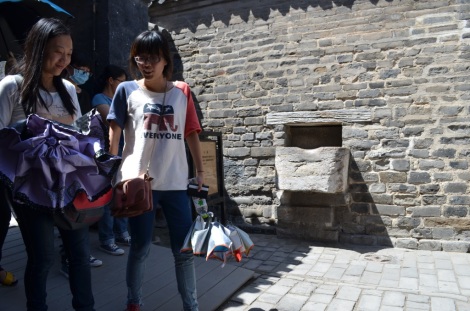
The “outer” servants would go fetch water, and then pour it through this hole in the wall. On the other side was a basin, from which the “interior” servants would fetch the water.
After leaving the mansion, I walked down to Confucius’s Forest, which is actually a massive cemetery. In Chinese custom, the deceased are cremated, and then the ashes are buried and a gravestone is erected. The guidebook told me that there were over 100,000 people, all descendants of Confucius, buried here. I at first doubted this, but walking through the forest and seeing so many headstones, and two different funerals taking place within the 2 hours I was near this area, I could believe that 100,000 is perhaps accurate. 100,000 graves in 2,500 years averages out to about 40 funerals a year, and that actually seems quite low when one considers that there are over 2 million people confirmed on Confucius’s family tree, and perhaps the actual number is closer to 3 million. 100,000 would thus only be 3-5% of all descendants.
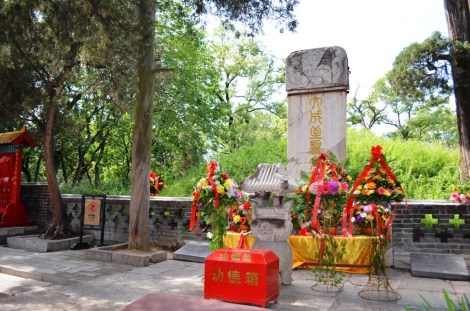
The Sage’s grave. This gravestone dates from the Ming Dynasty. Behind it is a smaller one, still in good repair, that was erected during the Yuan dynasty.
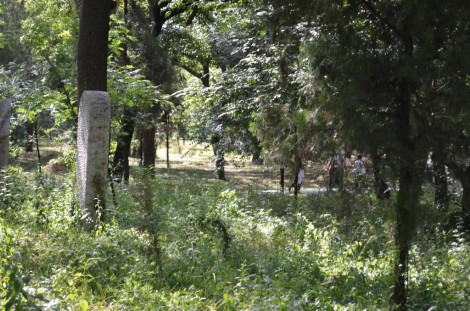
Walking through the woods; there were grave markers everywhere, and you can sort of make out a passing funeral through the trees.
Anyways, I saw Confucius’s grave, which really when you think about it is kinda cool. How many other 2500 year old people do we know where they are buried, especially when that person was neither royalty nor made any claims to be a deity? It’s also interesting that Confucianism itself survived. Obviously, the head of successfully invading armies, who then obviously went on to become the new emperor, would probably all like this political philosophy, and of course it was well established already, but even still, (most) invaders were willing to adopt Confucianism as both a political philosophy and quasi-religion, and never sought to replace it outright, contenting themselves with, at most, synthesizing their customs and views with locally-practiced Confucianism. Of course, Confucianism was abolished along with the official examination system in 1905, and Mao did a good job during the Cultural Revolution of stamping out any Confucianism that may have hung around. That said, Confucius seems to be making a comeback – statues of him are allowed, if not hastily being built, and the China’s overseas “educational” institutes are known as Confucius Academies. Anyways, I’ve digressed again…
On the way back to the bus stop, to get to the high speed rail station, I had a nice chat with some street-food vendors as I ate a few snacks. They were impressed that I could understand their thick accents, most foreigners couldn’t, and even some Chinese had trouble. I told them that I had spent a week nearby during the last Spring Festival and so I had some familiarity with their dialect, and then we got into the normal conversation of comparing our two countries – always a topic that local Chinese will bring up as much as I try to avoid it. Amazingly, and this is not the first time we have run into it, the woman I was talking to didn’t know that the US did not have a one-child policy.
I also stopped at the Yan Temple, which was established near Confucius’s home, and dedicated to Yan Hui, one of Confucius’s favorite disciples who died at the young age of 32, while The Master was still alive.

The most (only) interesting thing about the Yan Temple may have been this ceiling ornament. The picture doesn’t do it justice, but the dragon face is 3d and probably about a meter wide.
I also stuck my head in the place pictured below. Although I paid 20CNY, I still have no idea what the purpose of it was. It had large statues of “the 72 Disciples,” along with some paintings of important stories relating to Confucian thought. My entrance ticket came with a personal tour guide who was potentially training for the Chinese speed-talking championships. I had to keep asking her to slow down her speech, and reminding her that I could not understand ancient Chinese, so to please keep the quotes from her clearly well-memorized script to a minimum. She was really nice and good-natured though, and was impressed I understood her at all I think. Anyways, it was worth the 10 minutes I spent in here.
And with that, I wrapped up my trip to Qufu. Hopefully, The Sage will be smiling down on me during my defense on Friday! [update. yup, he was!!! woohoo!! I passed!!!]




